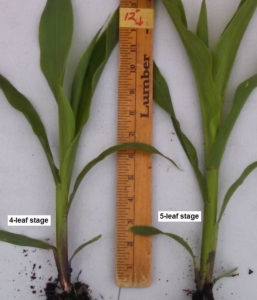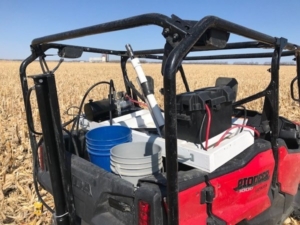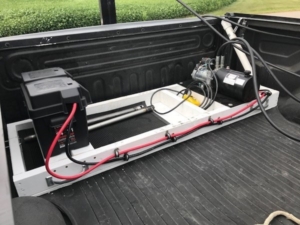Sidedress Corn Using the Pre-sidedress Soil Nitrate Test (PSNT)
As the corn crop begins to emerge, it is time to prepare for sidedress nitrogen applications. Sidedress nitrogen for corn can be applied any time after planting, but the target window is generally between growth stages V4 and V8, before rapid plant nitrogen uptake occurs. Split-applied nitrogen has become a standard practice in corn to reduce in-season nitrogen losses on vulnerable soils, such as sandy and clayey soils. More and more farmers now include topdress or sidedress nitrogen as part of their standard nitrogen management plan. These farmers have witnessed too many years with high in-season nitrogen losses through nitrate leaching or denitrification.
The target timing for PSNT sampling is when corn is 6 to 12″ tall. Twelve-inch corn is often V4 or V5 (like in the picture above). Do not hesitate in collecting soil samples for the PSNT; the target window for sidedress-nitrogen applications in corn is between the V4 and V8 stages.
Whether your nitrogen management plan includes a planned sidedress nitrogen application or not, the Pre-Sidedress Soil Nitrate Test (PSNT) is one tool to help make decisions about in-season nitrogen. You may also hear this test called the Late-Spring Soil Nitrate Test (LSNT) in Iowa. PSNT is an in-season soil nitrate test taken during the early growing season to determine if additional nitrogen fertilizer is needed. PSNT helps assess available soil nitrate-nitrogen prior to rapid plant nitrogen uptake and the likelihood of crop yield response to additional nitrogen.
The Pre-sidedress Soil Nitrate Test (PSNT), taken when corn is 6 to 12 inches tall, can help you decide the appropriate sidedress nitrogen rate. The PSNT requires a 0-12 inch depth soil sample taken when corn plants are 6 to 12 inches tall (at the whorl), usually in late May or early June. Late-planted corn may not reach that height before mid-June, but PSNT soil samples should still be collected during the first two weeks of June. The recommend soil sampling procedure requires 16 to 24 soil cores taken randomly through the field, staggering your soil cores across the row as you go. All soil cores should be placed in the soil sample bag and submitted to the laboratory within 24 hours or stored in the refrigerator.
You can submit PSNT soil samples using the online AGVISOR program by choosing the “Corn Sidedress N” crop choice and submitting a 0-12 inch soil sample for nitrate analysis. AGVISOR will generate sidedress nitrogen fertilizer guidelines, using the PSNT critical level of 25 ppm nitrate-N (0-12 inch depth). If PSNT is greater than 25 ppm nitrate-N, then the probability of any corn yield response to additional nitrogen is low. If spring rainfall was above normal, then the PSNT critical level of 20 to 22 ppm nitrate-N (0-12 inch depth) should be used. Iowa State University provides additional PSNT interpretation criteria for excessive rainfall, manured soils, and corn after alfalfa.
If the PSNT is taken after excessive rainfall, the soil cores will be wet and difficult to mix in the field. Therefore, it is best to send all soil cores to the laboratory to be dried and ground, ensuring a well-blended soil sample for analysis. Although in-field soil nitrate analyzers have improved over the years, the difficult task of blending wet, sticky soil cores in the field still remains. The only way to get accurate, repeatable soil analysis results is to dry, grind, and blend the entire soil sample in the laboratory before analysis. AGVISE provides 24-hour turnaround on PSNT soil samples. The soil samples are analyzed and reported the next business day after arrival. Soil test results are posted on the online AGVISOR program for quick and easy access. With AGVISE, you get not only great service but also the highest quality data with four decades of soil testing experience.
Pre-Sidedress Soil Nitrate Test (PSNT) resources
- Instructions for submitting PSNT online
- Late-Spring Soil Nitrate Test, Iowa State University
- PSNT in a delayed spring, Iowa State University
Please call our technical support staff if you have any questions on PSNT and interpreting the soil test results for sidedress nitrogen application.






